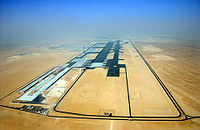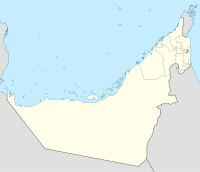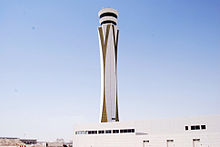- Al Maktoum International Airport
-
Al Maktoum International Airport 
IATA: DWC – ICAO: OMDW Location of airport in UAE Summary Airport type Public Operator Dubai Airports Location Jebel Ali / Dubai Coordinates 24°53′10″N 55°10′20″E / 24.88611°N 55.17222°E Website Runways Direction Length Surface ft m 12R/30L 14,764 4,500 Asphalt 12C/30C [1] 14,764 4,500 Asphalt 12L/30R 14,764 4,500 Asphalt Al Maktoum International Airport opened on 27 June 2010[2][3] Al Maktoum International Airport (IATA: DWC, ICAO: OMDW) is a major airport in Jebel Ali, Dubai, United Arab Emirates that opened on 27 June 2010. Previous working names have included "Jebel Ali International Airport," "Jebel Ali Airport City" and "Dubai World Central International Airport". It will be officially known as Al Maktoum International Airport. It has been named after the late Sheikh Maktoum bin Rashid Al Maktoum, the former ruler of Dubai. It will be the main part of Dubai World Central, a planned residential, commercial and logistics complex scheme. World Central is the world's first truly integrated logistics platform,[citation needed] with most transport modes, logistics and value added services, including manufacturing and assembly, in a single bonded and Free Zone environment.[4]
Contents
History
Construction
The A380 enabled 4.5 kilometres (2.8 mi) runway was completed within its projected 600 day construction period and subsequently underwent tests and trials over the next six to eight months in order to fulfill its CAT III-C requirements.[citation needed] Construction of the airport's cargo terminal, the Al Maktoum Airport Cargo Gateway, which cost around US$75 million, was 50% complete by the end of 2008.[5]
During the first phase of the project, the airport is planned to handle around 200,000 tonnes of cargo per year, with the possibility of increasing to 800,000 tonnes.[5] The passenger terminal at this phase is designed to have a capacity of around five million passengers per year.[6] By 2013, it is planned to be the largest airport in the world in terms of freight handled, moving up to 12 million tonnes per year.[5]
The project is expected to be fully built-out and operational by 2017, although the 2009 financial crisis may postpone the completion of the complex by 5 years to 2022.
Operations
Al Maktoum International Airport was opened on 27 June 2010[2][3] with one runway only and only cargo flights. Passenger operations are expected to begin in the fourth quarter of 2011.[7]
The first flight into the airport occurred on 20 June 2010, when an Emirates SkyCargo Boeing 777F landed after a flight from Hong Kong. The flight served as a test for various functions such as air traffic control, movement of aircraft on the ground, and security. According to Emirates, the flight was an "unmitigated success."[8]
On 24 February 2011, the airport was certified to handle passenger aircraft with up to 60 passengers, though according to Dubai Airports Company, Al Maktoum's operator, regular passenger flights were not expected to begin until late 2011.[9]
The first Passenger Aircraft touched down on 28th February 2011, an Airbus A319CJ.[10]
Airlines and destinations
At the time of its opening, three cargo service airlines served Al Maktoum International Airport, including RUS Aviation, Aerospace Consortium and European Cargo Services. Fifteen additional airlines have signed a contract to operate flights to the airport.[11]
Cargo Terminal
Airlines Destinations Martinair Cargo Amsterdam, Bahrain, Chennai, Doha, Hong Kong Overview
At the heart of this huge new community is the Al Maktoum International Airport, planned as the world's largest passenger and cargo hub, ten times larger than Dubai International Airport and Dubai Cargo Village combined.
If completed as planned, the airport will have an annual cargo capacity of 12 million tons, and a passenger capacity of up to 160 million people per year— which would be more than Hartsfield-Jackson Atlanta International Airport, which handled 90 million people in 2008,and is currently the world's busiest passenger airport.[12]
Designed for the future, Al Maktoum International Airport proposes to handle all next-generation aircraft, including the Airbus A380 super-jumbo.[13] Up to four aircraft will be able to land simultaneously, 24 hours a day, minimizing in-air queuing.
The airport will include:
- Five parallel runways, 4.5 kilometres (2.8 mi) in length, each separated by a distance of 800 metres (2,600 ft). Six runways were originally planned, but the number was reduced to five in April 2009.[14]
- Three passenger terminals, including two luxury facilities; one dedicated to airlines of The Emirates Group, the second to other carriers, and the third dedicated to low cost carriers.
- Multiple concourses
- 16 cargo terminals with a 12 million ton capacity
- Executive and Royal jet centres
- Hotels and shopping malls
- Support and maintenance facilities: the region's only hub for A, B, and C Checks on all aircraft up to A380 specifications
- Over 100,000 parking spaces (probably underground) for airport staff and passengers
- Al Maktoum International Airport and the existing Dubai International Airport will be linked by a proposed high speed express rail system
- Al Maktoum International Airport will also be served by the Dubai Metro and a dedicated Dubai World Central light railway
Facilities
The airport is planned to have five 4,500m parallel runways, with a large passenger complex in the middle. Three runways would straddle at one side of the complex while two more would be located at the other side. Furthermore, each runway would have extended asphalted pathways on either side which would allow aircraft to by-pass other runways and taxiways without disturbing aircraft movements of these runways and taxiways. The airport is the biggest section/component of Dubai World Central. If fully built it will be the world’s largest capacity for an airport with 120 million passenger/year capacity and a cargo capacity of 12 million tons/year.[15] Its large runways and the distance between would allow simultaneous take-offs and landings.
Dubai's expectations of an exponential rise in passenger traffic over its skies is built on the presumption that it would become the ideal air hub for transiting travellers from the Asia-Pacific Region, South Asia, Greater Middle-east, Africa, Europe, and Australia (for the Kangaroo route--Australia to Europe/Britain and vice versa).
Upon completion it will be the fourth largest air facility in land area (physical size). Only three other air facilities are/were larger than Dubai World Central:
- King Fahd International Airport in Dammam, Saudi Arabia (790 square kilometers)
- Montreal, Canada, the Montréal-Mirabel International Airport (392 square kilometers as originally planned in 1969, but as of December 2006, only about 50 square kilometers)
- King Khalid International Airport in Riyadh, Saudi Arabia (225 square kilometers)
The air complex would, perhaps, become the most Airbus A380-friendly air facility in the world since all the hard-stand aero bridge gates are capable of accommodating the aircraft, as the master plan model suggests.[citation needed]
The facility, however, will initially service cargo airlines. Several large warehouses and hangars line the westernmost part of the airport. These interlinked warehouses and/or hangars will stretch from end-to-end of the westernmost runway. Each of these warehouses and/or hangars are capable of housing A380 aircraft.
The airport will complement Dubai International Airport, some 40 km away. The airport itself is surrounded by a large logistics hub, an ultra-luxurious golf resort (with suburban housing interwoven between greens and fairways), an expansive trade and exhibition facility (3 million square metres of exhibition space—would become the world's largest single exhibition site/location/address/destination), a massive commercial district, and a spacious residential/housing district.[16]
Due to the massive physical scale of the masterplan, others would come to claim that Al Maktoum International Airport would be the most ambitious airport project ever envisioned. The latest estimates by the government of Dubai peg the price tag at US$ 82 billion.[17] This aerotropolis would be US$62 billion more expensive than the next most expensive airport project Hong Kong-Chek Lap Kok International Airport Core Project—which cost the Hong Kong government around US$ 20 billion (in 1997 dollars). This would also make it the most expensive single project in the world, ever (with the possible exceptions of the Dubai Waterfront, The Palm Deira, and New Songdo Intelligent City).[citation needed]
Parking
Dubai World Central (not just the international airport) will have a total of 100,000 parking slots for automobile vehicles for its employees, Dubai residents, tourists, and other users.[18] This will give the air facility the distinction of having the largest parking facility in the world.
References
- ^ Dubai Al Maktoum Completes Construction of 4,500m Runway Named 12/30 in text
- ^ a b http://www.arabianbusiness.com/582245-dubais-second-airport-to-open-on-june-27
- ^ a b http://www.dwc.ae/site/DubaiWorldCentraltogolivein2010SheikhAhmed.html
- ^ "Dubai World Central makes urban...". Dubai World Central. 2006-05-01. http://www.dubaiworldcentral.net/Details.353.0.html?&tx_ttnews. Retrieved 2008-02-14.[dead link]
- ^ a b c Staff Writer (2008, January 7) Arabianbusiness.com Dubai Cargo Village announces major restructure
- ^ "Dubai opens second airport". Seattle Post-Intelligencer. 28 June 2010. http://blog.seattlepi.com/aerospace/archives/212810.asp?source=rss. Retrieved 29 June 2010.
- ^ "No airline operations at Al-Maktoum before fourth quarter". http://www.flightglobal.com/articles/2011/02/24/353618/no-airline-operations-at-al-maktoum-before-fourth-quarter.html. Retrieved 2011-02-27.
- ^ "PICTURES: SkyCargo 777 tests new Dubai Al-Maktoum Airport". Flightglobal.com. 21 June 2010. http://www.flightglobal.com/articles/2010/06/21/343468/pictures-skycargo-777-tests-new-dubai-al-maktoum-airport.html. Retrieved 25 June 2010.
- ^ "No airline operations at Al-Maktoum before fourth quarter". Flightglobal.com. 24 February 2011. Archived from the original on 24 February 2011. http://www.webcitation.org/5wjrecZup. Retrieved 24 February 2011.
- ^ "First Passenger Aircraft landed". Smartarabs.com. http://www.smartarabs.com/products-a-services/airlines-a-aviation/1199-dubai-airports-launches-general-aviation-at-dwc-with-inaugural-flight. Retrieved 24 February 2011.
- ^ "Al Maktoum International airport begins operations". Gulf News. 27 June 2010. http://gulfnews.com/business/aviation/al-maktoum-international-airport-begins-operations-1.646783. Retrieved 22 July 2010.
- ^ "The new Al Maktoum International Airport opens in Dubai tomorrow and will be the worlds busiest airport". Dubai Informer. http://dubaiinformer.com/featured/3594/the-new-al-maktoum-international-airport-opens-in-dubai-tomorrow-and-will-be-the-worlds-busiest-airport/. Retrieved 27 June 2010.
- ^ http://www.airport-technology.com/projects/al-maktoum/
- ^ http://zawya.com/cm/profile.cfm/cid1002956
- ^ Zeidan, Ghaleb (2009, November 9) pr2live.com Dubai Aviation City Corporation Executive Chairman outlines Dubai’s strategic focus on transport and logistics at SITL Dubai 2009
- ^ Press Release (2007, Nov 11) Dubai World Central DUBAI WORLD CENTRAL AVIATION CITY MASTER PLAN LAUNCHED
- ^ http://www.zawya.com/projects/project.cfm/pid060707061036?cc
- ^ http://www.airport.ae/al-maktoum-international-airport-dubai-world-central-uae.html
External links
- The Official Dubai World Central web site.
- Al Maktoum International Airport Dubai - the worlds busiest Airport to be
Dubai topics History · Geography · Government · Culture GeographyGovernmentAmerican University in Dubai · Dubai Men's College · Dubai Women's College · Birla Institute of Technology and Science · Zayed University · SP Jain Center of Management · Mahatma Gandhi University · Our Own English High School · The Indian High School · Dubai Modern High School · Dubai British School · English College Dubai · International School of Choueifat · American School of Dubai · Dubai American AcademyReligionTowns · Buildings · Places · Structures TownsBuildingsParksReal estateBridges and
tunnelsEconomy · Trade · Commerce Trade and
commerceEmaar · Nakheel · Dubai Holding · ARY Group · Al-Ghurair Group · Ashai Group International · Etisalat · Du · Dubai Ports World · Art · Dubai Gold Souk / Spice SoukPortsJebel Ali · Dubai Internet City · Dubai Media City · Dubai Knowledge Village · Dubai Healthcare City · Dubai Studio City · Dubai International Financial CentreShopping mallsTransport TransportDubai International Airport · Abra · Dubai Metro (Red Line · Green Line) · Palm Jumeirah Monorail · Emirates Airlines · Sheikh Zayed Road · Emirates Road · Al Maktoum International AirportSister cities Developments in Dubai Skyscrapers Shopping centres Entertainment Transport Dubai Metro (Red Line • Green Line) • Dubai World Central (Al Maktoum International Airport) • Palm Jumeirah MonorailLand reclamation Other projects List of development projects in Dubai • List of tallest buildings in DubaiCategories:- Proposed buildings and structures in Dubai
- Proposed airport expansion
- Airports in the United Arab Emirates
- Government-owned companies in the United Arab Emirates
Wikimedia Foundation. 2010.



